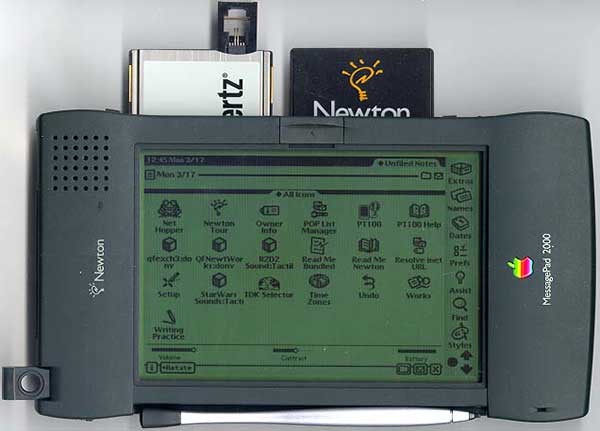In an interview with Charlie Rose on Wednesday, Qualcomm CEO Paul Jacobs said Apple turned down an offer to incorporate the company's radio technology in the Newton PDA, a move that would have created a proto-iPhone smart device.
During the interview, Jacobs told Rose (via VentureBeat) that before smartphones existed, he pitched an idea to Apple that had in it the basic underpinnings of the now prolific mobile technology: a Newton PDA with embedded Qualcomm radio for cellular communication. The idea was rebuffed and Jacobs took his plan to now-defunct PDA maker Palm, which ultimately partnered with the company to create the Qualcomm pdQ.
While largely a forgotten device in a sea of mobile electronics from the 1990s, the pdQ is arguably one of the first smartphones to hit the consumer market. The application driven OS and mobile capabilities were a precursor to modern products like Apple's iPhone and offerings from Android handset makers.
At the time, Apple chose to go another way with the Newton, offering customers expansion slots for customizable connectivity options instead of building in a dedicated radio, which would have added heft to the already large device. Even Qualcomm's offering, seen as a kind of hybridization of the PDA and cell phone, was gigantic compared to today's standards.
From a CNN feature from 1999 regarding the pdQ:
The unit itself is fairly large for a cell phone. At 6.2 inches tall, 2.6 inches wide and 1.4 inches thick, it is too large to fit into a shirt pocket comfortably. It can slip into the pants pocket of a pair of khakis, although a belt holster would be more appropriate. Weightwise, it comes in at around 9.8 ounces, but isnt uncomfortable to hold for long periods of time while talking.
Compare those specs to the iPhone 5's svelte chassis standing 4.87 inches tall, 2.31 inches wide and 0.3 inches thick with a weight of 3.95 ounces, not to mention the bevy of cellular and communications radios, 4-inch Retina display, speedy A6 processor and advanced microchips Apple was able to cram into the small aluminum housing.
Still, Jacobs' story offers a look at what might have been given Apple's strong performance in the smartphone market that many believe was brought into the mainstream with the first iPhone in 2005.
Jacobs will be kicking off the Consumer Electronics Show in Las Vegas next week with a keynote speech, replacing the usual speaker Microsoft's Steve Ballmer.
 Mikey Campbell
Mikey Campbell







-m.jpg)






 Charles Martin
Charles Martin
 Christine McKee
Christine McKee
 Wesley Hilliard
Wesley Hilliard
 Malcolm Owen
Malcolm Owen
 Andrew Orr
Andrew Orr
 William Gallagher
William Gallagher
 Sponsored Content
Sponsored Content







23 Comments
... Still, Jacobs' story offers a look at what might have been given Apple's strong performance in the smartphone market that many believe was brought into the mainstream with the first iPhone in 2005. ...
That was the secret mainstream iPhone, right?
Did you read Defying Gravity, the story of the Newton's development? The development team definitely wanted both kinds of connectivity (what would come to be wifi and cellular data) in the device, but were hobbled by factors such as (1) it would've made the unit cost about $4000 at the time and (2) such a device presented a threat to the Mac department, who didn't want yet another pirate flag raised against the leading product (the way they'd done themselves against the Apple II earlier, and seeing how tablets and smartphones now replace certain computer functions, with good reason... not that that's an excuse for hobbling the project politically). http://www.amazon.com/Defying-Gravity-The-Making-Newton/dp/0941831949
Did you read Defying Gravity, the story of the Newton's development? The development team definitely wanted both kinds of connectivity (what would come to be wifi and cellular data) in the device, but were hobbled by factors such as (1) it would've made the unit cost about $4000 at the time and (2) such a device presented a threat to the Mac department, who didn't want yet another pirate flag raised against the leading product (the way they'd done themselves against the Apple II earlier, and seeing how tablets and smartphones now replace certain computer functions, with good reason... not that that's an excuse for hobbling the project politically). http://www.amazon.com/Defying-Gravity-The-Making-Newton/dp/0941831949
While the technology has obviously evolved greatly to make all of this possible (at a much lower cost), it seems that Apple evolved in some important ways, namely being willing to cannibalize their own products (ideally in a controlled and systematic way.) Today I have no doubt that they won't mind terribly if the iPad ends up replacing the Mac. For many users it likely will in fact. I'll go further and suggest that iPad is a closer manifestation of what Steve Jobs originally wanted to achieve with the original Mac: A very consumer-oriented, sealed, non-expandable, easy to use computing appliance.
It probably would've been a good idea for Steve to instruct his people to patent such a variation "just in case". Ah, history... You are difficult to face in retrospect.
Ballmer is not giving the CES keynote? That sounds like the bigger story.